Creating SEO content is rarely a walk in the park. So, it’s no wonder that an estimated 90.63% of all web pages receive no organic traffic at all.
If you suspect that some of your own web pages might be making up this 90.63%, have you ever considered why your content might not be performing as well as it could be?
A leading reason may be that you don’t have a well-defined SEO content strategy in place.
At Bynder, we know from our customers that an SEO content strategy is an important ‘building block’ to have in place for all the content creation that follows thereafter.
For example, the charity Anthony Nolan managed to decrease the size of the images on their website by 50%, which resulted in a marked improvement in their content’s SEO rankings — as well as quicker page load speeds.
Of course, implementing SEO improvements like the above can ultimately help you to provide excellent content experiences to your consumers too.
So, if you’ve already looked into what influences SEO rankings, but haven’t quite known where to start with your own content, you’re in luck. We’re about to unpack all the actions you need to take via our seven-step framework for creating a high-performing SEO content strategy.
What is SEO content?
SEO content is content meant to drive organic traffic from search engine results pages (SERPs).
Content optimization is a big part of accomplishing that goal. It’s what helps your content rank on page one of Google and, preferably, within the first few organic positions — where it can be most easily found by your audience.
However, the kind of content that deserves to rank well isn’t just optimized for search engines; it also keeps the reader's experience in mind. In other words, it’s content that answers all of the reader’s questions — based on their original target keyword or phrase.
‘SEO writing’ and ‘writing for your audience’ are really the same thing. And because search engines like Google prioritize satisfying their users, when your content does that, it ends up ranking well.
It’s a ‘win-win’ situation because when a user finds their answer on your page, they are then likely to spend more time on your site. This increases your click-through rate (CTR) and reduces your bounce rate — because the content you’ve provided is relevant.
CTRs and bounce rates are significant ranking factors (based on what we know about how search engines like Google work), so improving them can positively impact your SEO content rankings.
Why is SEO content important?
A typical answer might be that high-ranking SEO content generates website traffic.
But ‘traffic’ is a secondary goal here; it’s the effectiveness of the content itself once someone is on your site that often leads to the conversion of customers or users.
So perhaps it’s more accurate to say that SEO content generates relevant, higher-quality website traffic. It helps the people with the most potential of converting to find your website.
This visibility and accessibility boost brings additional benefits too. For example, say your website constantly shows up in search results for a topic your audience is researching. If your content is engaging and meets their needs, it can boost your credibility (and memorability).
Your target audience will begin to see you as an authority on the subject, which means more chances to engage and build relationships.
Both can lead to sales or other important outcomes in the future.
SEO content types you should consider creating
What type of SEO content can you create to enjoy the benefits we’ve outlined above?
Here are some of the most common SEO-friendly content types:
- Lists or ‘listicles’: For example: “101 newsletter ideas to try today.”
- Guides: This is in-depth, detailed long-form content on a particular topic.
- Articles: These could be news, interviews, or features.
- Blog posts: These often answer a target audience member’s question or explain a particular concept or process.
- Infographics: These visualize data and help capture organic traffic of searchers looking for quick answers or information.
- Product pages: These offer product descriptions and other related content.
- Images and slideshows: These could be anything from supplementary and explanatory images to a PowerPoint presentation.
- Videos: These could be bite-size clips or long-form videos that comprehensively explain a product, topic, or concept.
Creating your SEO content strategy: A 7-step framework
The worst thing you can do is pick one or more of the content types above and ‘just start creating’.
As with your overall marketing efforts, a strategy is essential. So, to make sure you’re doing SEO content right, follow these steps:
1. Identify your audience
To create a successful strategy, you must first know who it’s aimed at.
Start with identifying your target audience. Then, look for the common themes linked to:
- Their pain points, their impact, and their severity
- Their goals, or the outcomes they’re after
- The way they speak about the pain points and goals they have
- The solutions they’ve looked into, and how they feel about those options
Gathering this type of information with as much accuracy as possible will help guide your keyword research and content creation efforts.
2. Decide on your goals
Write down your goals for creating SEO content — do you just want to drive organic traffic, or do you want to attract more conversions?
According to David Farkas, Founder of The Upper Ranks, your goals can include:
- Obtaining certain rankings for target keywords; especially those that are high-priority
- Increasing organic traffic and conversions by a certain percentage within a certain timeframe
- Increasing average time on site and user engagement
As you set goals, though, be sure to think about the bigger picture. Wins like increased traffic and better rankings are great, but only if they lead to more meaningful outcomes that grow the business or further your cause.
3. Research keywords and validate ideas
Your audience research can be a goldmine of keywords, phrases, and frequently asked questions.
It’s a good idea to research variations and questions related to a seed keyword, and from there, create a large spreadsheet to capture everything, along with the keywords’ estimated search volume, keyword difficulty level, and estimated cost-per-click (CPC).
If you’re only just starting out with keyword research, you may want to target mainly long-tail keywords. These are typically less competitive, giving you a better chance at ranking well in search results.
Once you have a list of potential keywords, you can move on to brainstorming content topics.
To choose the right topics, you must understand each keyword’s search intent. Luckily, there are many tools you can use for brainstorming. You can, for example, find topic ideas in Ahrefs’ Keyword Generator Tool, Google Keyword Planner, by scouring Google’s ‘People Also Ask’ feature, and by reading through relevant forum entries in places like on Reddit and Quora.
For each keyword, you’ll also need to decide the content type that will be created around it. Will it be a guide, a ‘how-to’ piece, a short-form article, or something else?
4. Audit your existing digital content
At this point, you’ll have a clearer understanding of the topics you’ll need to cover in future. But, don't start planning new content based only on your keyword research; before you get ahead of yourself, invest some time in auditing your existing digital content. You should find that there are four ‘buckets’ that your existing items might fall into:
- It’s in need of a minor update: It’s hitting the keyword sweet spot, but could it be freshened up with some new statistics or information? Perhaps some insightful quotes from subject matter experts? And could you improve on its overall readability, for example, by tightening up the formatting?
- It’s in need of a major update: Large updates may include expanding a piece, optimizing it for a different intent or audience, or updating your organization’s stance on a certain topic.
- It can be merged with something else: You may find that you have several pieces on the same topic and that they overlap significantly. It’s a good opportunity to combine all the best bits into one in-depth post.
- It can be deleted: If a piece is too out of date, is no longer relevant, or happens to be miles off from your current proposition, seriously consider scrapping it. It’s better — both in terms of user experience and SEO — for it to be removed from your site sooner rather than later.
Taking stock of the content you have helps you use your resources wisely and reach better SEO results faster. Plus, it’s usually easier to update existing content than to create it from scratch.
Lastly, getting a good understanding of the existing content you hold can prevent older pieces from unexpectedly ‘competing’ with any new pieces you create on the same topic.
5. Create an editorial calendar and content briefs
With your list of target keywords and topics ready, you’re ready to organize them into an editorial calendar. For each topic, you should add details including the due date, who will be creating that content, and who will be approving that content.
A tool like Content Workflow by Bynder allows you to build bespoke workflows for your content and assign dates, tailored notes, and approvers to each item. It's an easy way to get an overview of what’s due in a calendar format:
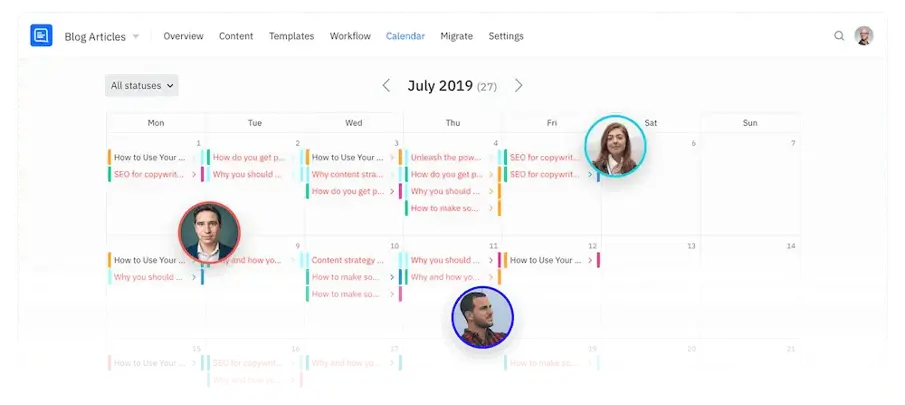
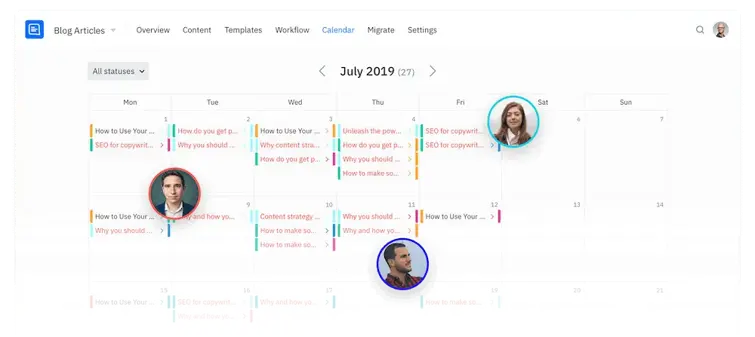
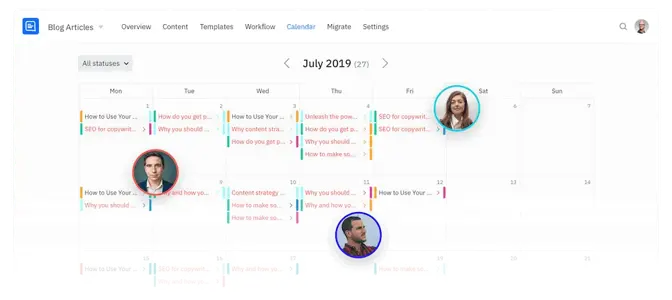
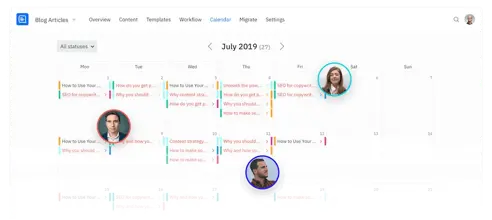
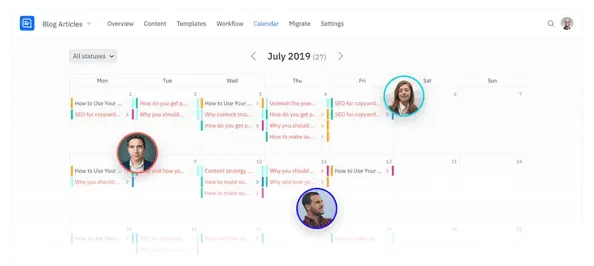 Content Workflow helps you to create editorial calendars easily and effectively
Content Workflow helps you to create editorial calendars easily and effectively
Your writers should then create high-quality content for you based on high-quality content briefs. These should set out information such as:
- The content item’s focus keywords and secondary keywords
- Its target audience
- Any important brand messaging that needs to be included
- How each piece of content will meet the audience’s needs
Once again, a tool like Content Workflow by Bynder can assist you in creating high-quality content briefs through the use of templates. You can even embed detailed instructions and SEO-related guidelines for each content piece if you need to:
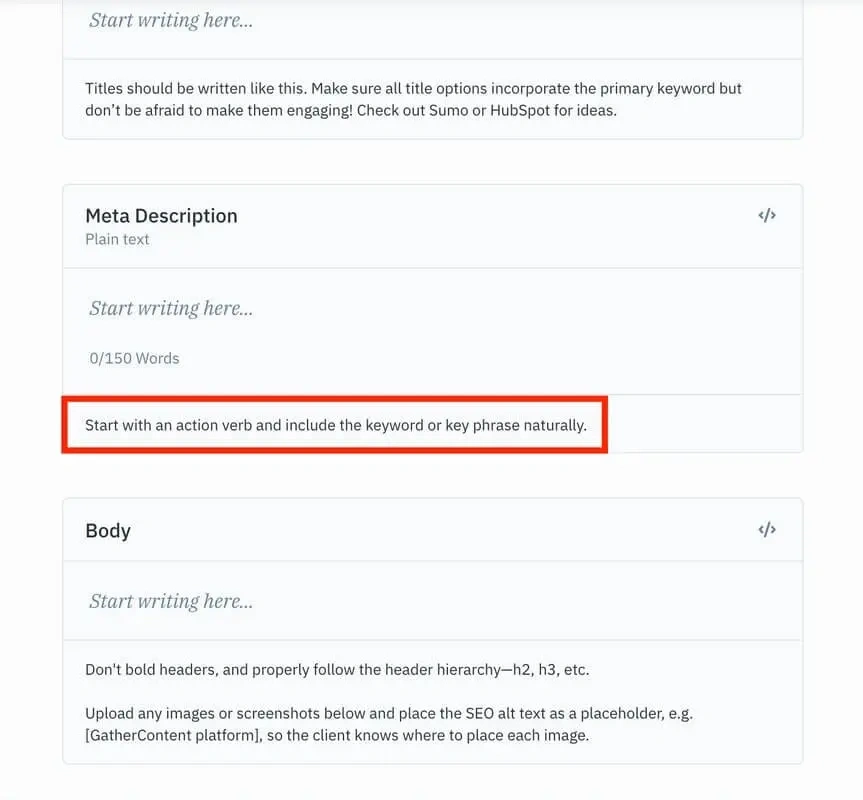 Use Content Workflow to embed SEO-related guidance into your content briefs
Use Content Workflow to embed SEO-related guidance into your content briefs
6. Create a link-building plan
In a nutshell, link-building can boost your website’s domain authority and improve its rankings. Creating a comprehensive post on a target keyword and waiting for it to rank ‘naturally’ is often not enough — particularly if you have a relatively new website.
Link-building means actively building backlinks to each piece of content by identifying relevant, credible websites that are prepared to link to others’ content. It could be a media or news site, or an industry body, for example. The key is to explore what’s out there, check the credentials of their website (for example, their Domain Authority ranking), and then reach out to your selected organizations to start a conversation.
It’s possible that your organization can indeed provide them with some valuable content that offers value to their readers in return for a backlink, but in some cases, your organization may have to be a good fit and offer valuable content, and be willing to pay some kind of fee for the backlink arrangement to be secured.
7. Publish and track your results
Once you hit publish, be sure to track the performance of your content.
For example, you can utilize Google Analytics in order to understand:
How much traffic your posts are driving to your website
How long visitors are spending on the page
What visitors are clicking on and the paths users take on your site
Which pages are delivering conversions
How can you be sure you’re tracking progress the right way, though?
You can pre-select the metrics you plan to monitor based on your pre-set goals. Every quarter or so, you can review progress against these metrics.
Finally, an important piece in the SEO content strategy puzzle is to keep refreshing your existing evergreen content. We recommend this because the Google algorithm loves ‘fresh’ content, and prioritizes it when ranking search results.
This can be added as a step in your overall content workflow process if you’re using a tool like Content Workflow by Bynder. Content Workflow allows you to embed your own instructions and brand guidelines within content templates; including any SEO pointers content creators should be bearing in mind whilst they’re writing.
Ready to make everyone’s life easier? Explore the ultimate solution for smoother SEO content creation by starting a free trial of Content Workflow today.












